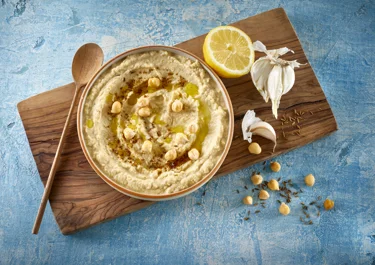Hummus

Hummus is a spiced chickpea mash used as a snack or starter. Though it originates in the Middle East, it is popular across the globe. It is very easy to make at home and since it has many uses – it is great as a dip for vegetables and bread or as a spread or dressing in salads, pitas, wraps, sandwiches, and burgers – it may just become a new favourite staple in your refrigerator. This recipe for hummus with tahini is simple, quick, and easy and the result is a wonderfully creamy dip packed with flavour.
Ingredients
Hummus:
|
Chickpeas in brine (approx. 400 g)
|
1 can |
|---|---|
|
Tahini (toasted sesame paste)
|
1 tbsp |
|
Olive oil
|
1 tbsp |
|
Freshly squeezed lemon juice
|
1½ tsp |
|
Garlic clove
|
1 |
|
Ground cumin
|
1 tsp |
|
Coarse salt
|
1 tsp |
|
Greek-inspired yoghurt 10%, skyr, or curd cheese
|
75 ml |
Garnish:
|
Olive oil
|
|
|---|---|
|
Ground cumin
|
|
|
Chickpeas
|
Served with:
|
Cucumbers, cut into sticks
|
2 |
|---|---|
|
Red pepper, cut into sticks
|
1 |
|
Green courgette, cut into sticks
|
125 g |
Instructions
Tips
You can soak fresh chickpeas instead of using canned ones. Put 120 g of dried chickpeas in a bowl and pour water over them. Cover them and leave the chickpeas in the fridge for about a day. The next day, put the soaked chickpeas in boiling lightly salted water. Cook them for about 45 minutes or until they are tender. Dried chickpeas often have a more pronounced nutty flavour than canned ones, but your dip will taste delicious no matter which variety you use.
Questions about hummus
With our easy hummus recipe, making a delicious dip to enjoy with vegetables or bread as a flavour-packed snack is incredibly simple. Continue reading to learn more.
What is hummus?
Hummus is a Middle Eastern chickpea dip or spread often served as a snack or starter with bread, crackers, or a selection of fresh vegetables. The sepia yellow chickpea dip is usually served in a bowl and garnished with spices like cumin or paprika, herbs like parsley, nuts, whole chickpeas, and olive oil to make it look even more enticing when served.
What is hummus made of?
The chickpea dip is made by blending chickpeas, olive oil, lemon juice, garlic, tahini, cumin, and salt. A bit of Greek-inspired yoghurt, curd cheese, or skyr is added to ensure a smooth and creamy texture. It may be prepared using either canned chickpeas or dried chickpeas although these need to be soaked, cooked, and cooled in advance. It may be flavoured using a vast array of different ingredients like roasted peppers, eggplant, beetroot, avocado, cauliflower, sweet potato, carrot, pumpkin, and bean types like black beans, edamame beans, kidney beans, or white beans.
What to eat with hummus?
There are many ways to enjoy the well-loved chickpea dip. Popular ways to eat it include using it as a dip with crispy, fresh vegetables or bread like pita bread and flatbread. It is also delicious slathered on falafel or with falafel in pita bread as the chickpea flavours in both the dip and falafel complement each other well. You can also use it as a tasty spread in wraps, sandwiches, or burgers. Some even use it to make savoury hummus breakfast bowls with eggs, bacon, kale, avocado, and crumbled feta cheese.
Can you freeze hummus?
If you have made a bit too much homemade hummus – if there even is such a thing as too much – you will be glad to know that you can freeze the leftovers! Stored in an airtight container, it will keep for up to 4 months. Remember to leave some room in the containers for it to expand as it freezes. If you are unsure about the airtightness of your containers, you can wrap them in a layer of cling film or pour a thin layer of olive oil onto the surface of the dip. Also, the smoother the texture, the better it freezes. Thaw it overnight in the fridge and stir it before serving to ensure that any oil that may have separated from it is re-incorporated.
How long does hummus last in the fridge?
Homemade hummus has a shorter shelf life than the store-bought kind. But if you make sure to refrigerate it in an airtight container it should keep for up to 3-4 days. If you do not have time to enjoy it within a few days of making it, consider freezing it to prolong its shelf life considerably while retaining its characteristic smooth texture. Do not let the dip sit out for more than 4 hours as leaving it unrefrigerated will lead to it spoiling faster.
How to make hummus with dried chickpeas?
While making this chickpea dip is faster with canned chickpeas, you can also opt for dried chickpeas. However, you need to plan a bit in advance as the dried kind needs to soak in cold water for at least 12 hours before boiling. Boiling dried chickpeas takes about 45 minutes. Once the boiled chickpeas have drained and cooled, you can use them just as you would canned ones by blending them with the rest of the ingredients.
How to make hummus without tahini?
Though ours is a hummus recipe with tahini, it is possible to prepare the beloved chickpea mash without the addition of the toasted sesame paste. However, as it helps ensure a smooth and creamy dip and adds a lovely savouriness and slight bitterness to the earthy dip, you may feel as though something is missing both in terms of taste and texture. If you do not enjoy the unique sesame flavour of tahini, you can try replacing it with another nut butter like cashew butter, almond butter, or even sunflower butter to ensure the dip's delicious consistency.
Homemade hummus dip
Our smooth hummus with tahini made with olive oil and Greek-inspired yoghurt has a deliciously creamy texture. Along with the blended chickpeas, these wonderful ingredients create a smooth and rich dip that we bet will soon become your favourite.
The chickpeas, for which the dip has gained its Arabic name, have a subtle earthy taste with nutty undertones but much of the well-known flavour comes from flavourful tahini, fresh and acidic lemon juice, sharp and fragrant garlic, and ground cumin which adds a warmth and richness to the dip and plays up the earthiness of the chickpeas.
Though you might have stumbled upon a recipe for hummus without tahini, traditional recipes usually call for the use of the slightly bitter nut butter made from roasted sesame seeds. As the intense, recognisable sesame flavour is well worth a try, we also suggest using tahini as it gives it some wonderful savoury and nutty flavours.
Flavourful garlic hummus for vegetable sticks
Vegetables and hummus make a classic snack combination enjoyed by adults and children alike. The smooth and creamy texture works incredibly well with crispy vegetables like cucumber, red pepper, and squash but possibilities are endless, and you can serve it with any kind of vegetable, depending on what you like or what produce is in season.
If you are looking for different ways to use your homemade dip, it also tastes great as a snack with crackers, grilled homemade pita bread, and warm flatbread. It may of course also be used with these versatile bread types to make stuffed pitas or wraps. If you enjoy it as a savoury spread or dressing, try using it in salads, sandwiches, or as part of your selection of burger toppings next time you use our chicken burger recipe.
Experiment with different flavours
Although the basic recipe is irresistible as is, no one is saying that you should not try shaking things up once in a while. There is so much opportunity to play around with the ingredients for hummus as the chickpea and tahini go well with so many other flavours. Below, we have curated a selection of different, delicious hummus types to inspire your experimentation using our recipe as the base.
Beetroot hummus
If you enjoy the earthy flavours of cumin and chickpeas, incorporating cooked beetroots into this Middle Eastern dip is a good way to create a vibrant and eye-catching variant with additional earthiness. Beet hummus has a beautiful, bright fuchsia colouring and a slightly sweet flavour that pairs nicely with somewhat bitter salad ingredients like spinach and kale.
Roasted red pepper hummus
Red peppers are a popular ingredient in many different types of dips like the Turkish yoghurt-based haydari and the Greek feta-based htipiti. The roasted peppers bring sweetness as well as a lovely smoky flavour to any dip, making them a tasty addition to the basic chickpea hummus ingredients. The smoky flavour profile of the orange dip lends itself well to a step in a spicier direction. If this sounds appealing to you, try adding a bit of fresh or ground chilli with the roasted red peppers.
Avocado hummus
Mixing the traditional Middle Eastern dip with the immensely popular Mexican guacamole by adding avocado, cayenne pepper, lime juice, and a bit of fresh coriander into the mix is also a great option for anyone wanting to shake things up. The fusion of the different spices is amazing, and the mild-tasting avocadoes give the avocado hummus dip an irresistible green colour and make it deliciously creamy.
Black bean hummus
Black beans are mild and easily soak up the added spices, making for a tasty and flavourful dip. Simply add a handful of black beans to the basic ingredients and blend until smooth. Darker in colour, this black bean hummus is also incredibly creamy as black beans are naturally creamy and soft and, as such, blend very well.








